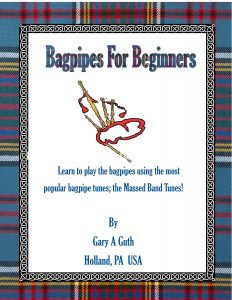 Learning to play the Bagpipe is about coordination and muscle memory long before it is about the actual music. I find in working with my students that they don’t do enough repetitions. If you have a gym membership and go regularly, each exercise has a number of “reps” needed to complete the task. If you only do 2 reps on each exercise, you’re not going to get the full benefit of that exercise.
Learning to play the Bagpipe is about coordination and muscle memory long before it is about the actual music. I find in working with my students that they don’t do enough repetitions. If you have a gym membership and go regularly, each exercise has a number of “reps” needed to complete the task. If you only do 2 reps on each exercise, you’re not going to get the full benefit of that exercise.
In my program “Bagpipes For Beginners” I have created an exercise program built around the tunes of the massed bands. Each tune, up to Scotland the Brave, has a prep drill sheet. I’ve extracted elements from each tune for the drills. Each drill is divided by measure, ultimately building the ornament from a given note. Between each measure is a repeat sign with a number 20 over the top. That is the minimum number of reps that you should do on that measure.
Since I’m not there supervising the students’ practice sessions, the other barometer is their satisfaction with the element they are practicing. I ask them: “Are you satisfied with the result, before you move on?” If it is still not at par, this is where I- the teacher – comes in to raise that bar and give them more realistic expectations of how that element is supposed to sound.
I have found that when a person reaches a certain number of repetitions, they spike and then the exercise starts to accelerate. If you are practicing in this manner, you need to be patient and trust yourself as to when that happens. If you push yourself too fast, you won’t accomplish the task, which is building muscle memory.
Bagpipe technique takes years to develop. You’re not going to master a Taorluath in one sitting. Practicing regularly and doing enough repetitions will develop the muscle memory needed to play with good technique.


0 Comments